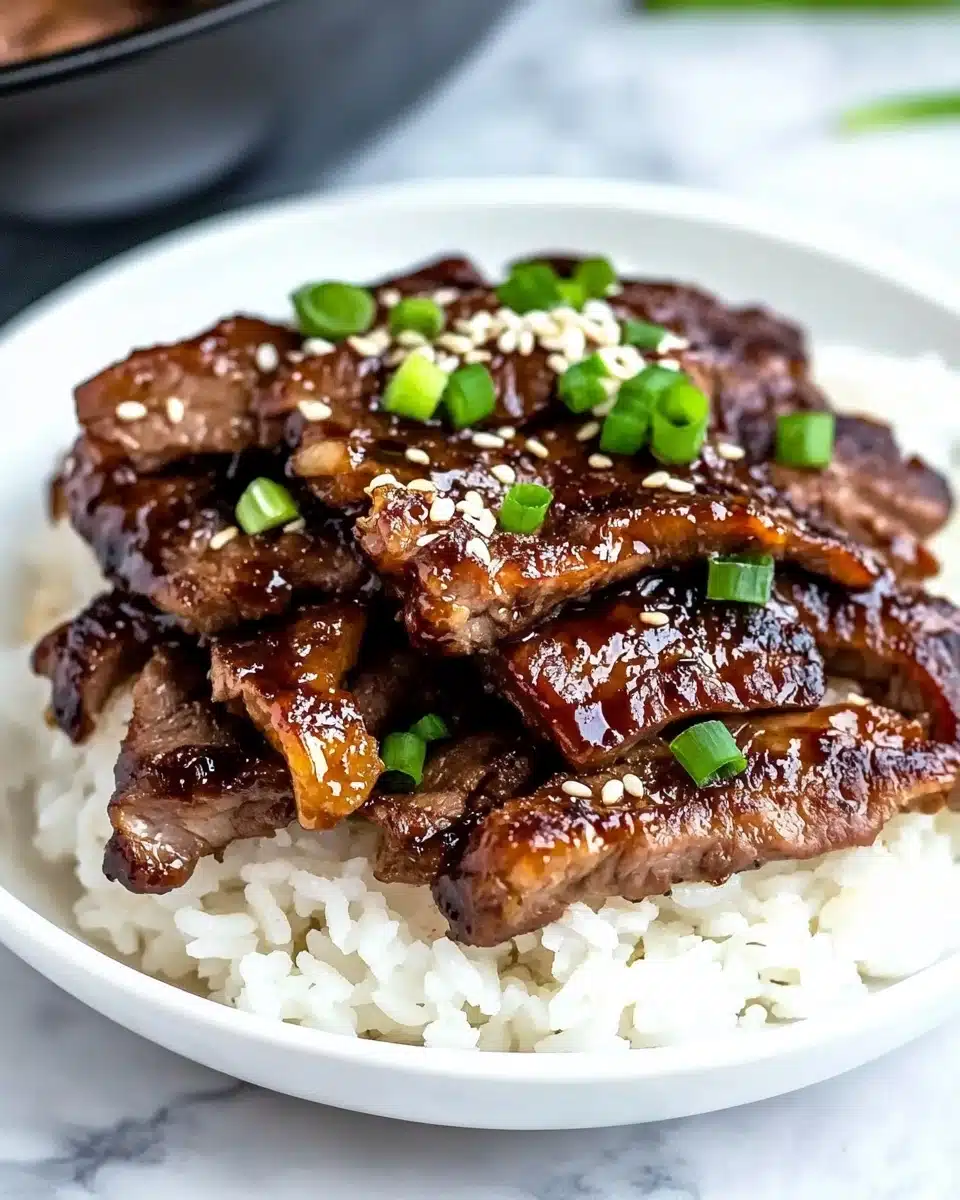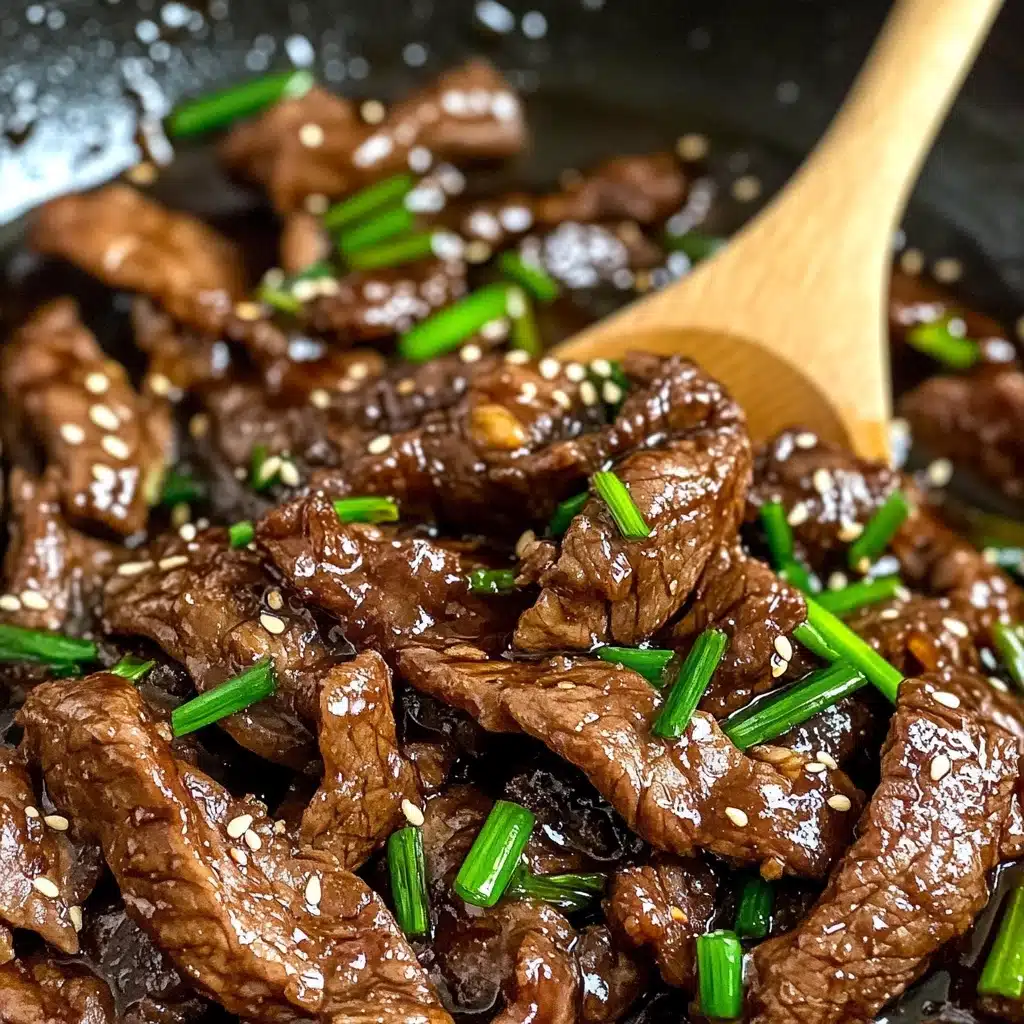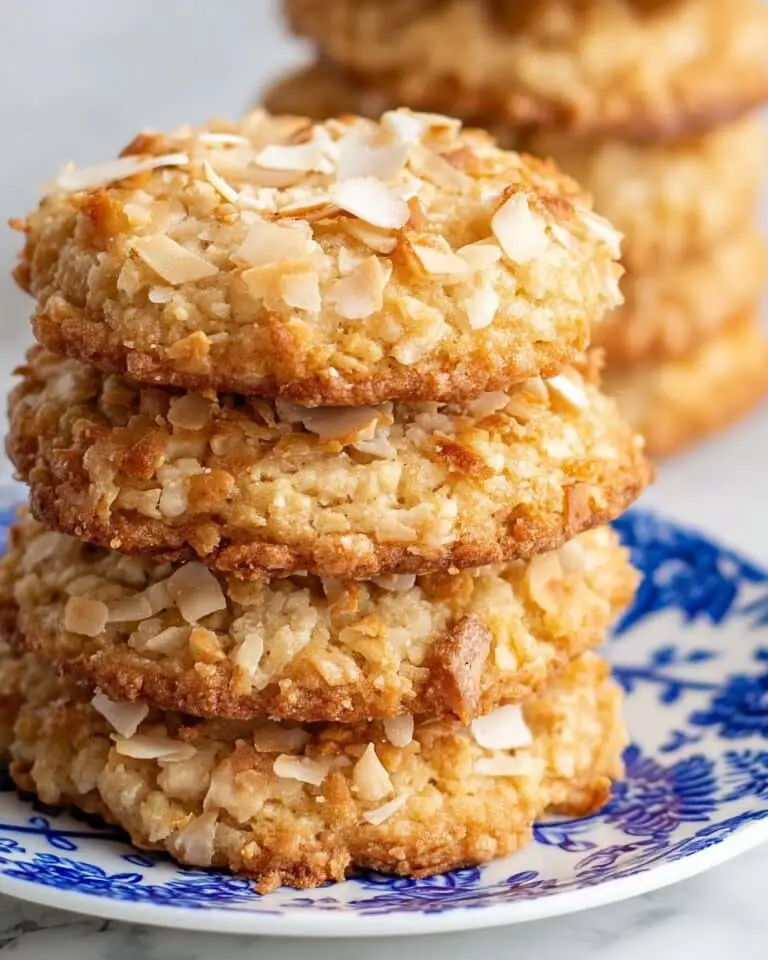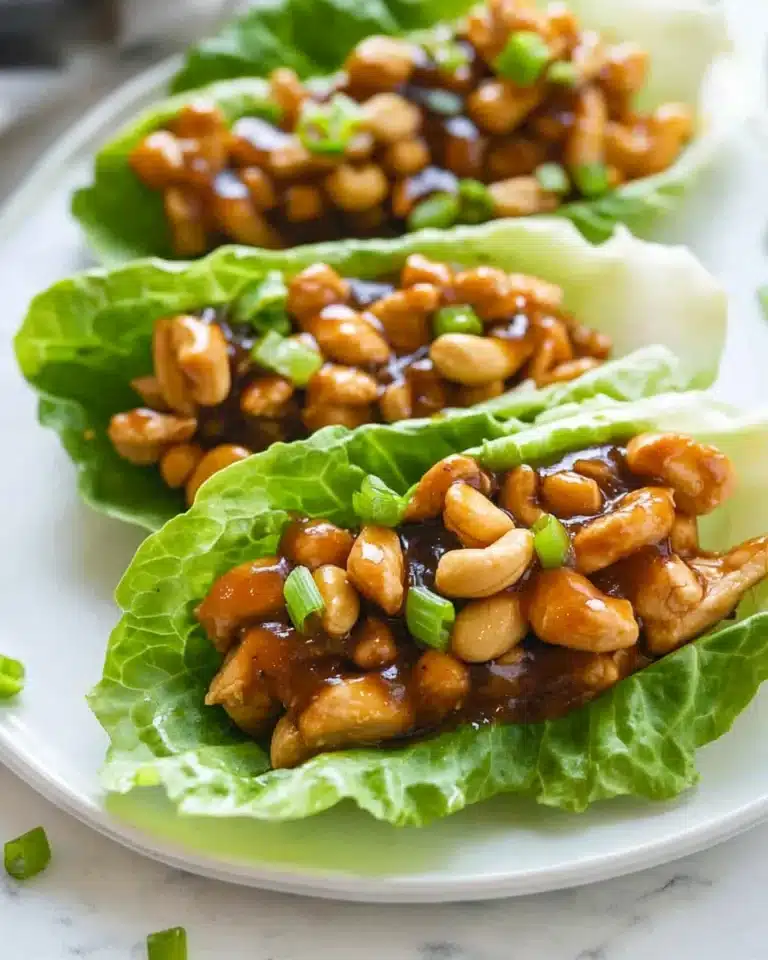If you’ve ever tasted the sweet-savory magic of Korean Beef Bulgogi, you know why this dish leaves people craving more after the very first bite. Thinly sliced beef marinated in a fragrant mixture of soy, ginger, garlic, and Asian pear, then seared to irresistible caramelization—Bulgogi is a true celebration of balance, flavor, and texture. It’s my go-to for impressing guests, treating myself, or making weeknight dinners feel special.
Why You’ll Love This Recipe
- Buttery-Tender Beef: Flash-cooked, thinly sliced beef soaks up a bold marinade and stays juicy and melt-in-your-mouth soft.
- Irresistible Sweet-Savory Sauce: The magical combination of soy, brown sugar, sesame, and Asian pear delivers that signature bulgogi umami with a hint of caramelization.
- Perfect for Weeknights or Entertaining: Marinate ahead, then simply sear and serve—Bulgogi is fast, impressive, and crowd-pleasing!
- Totally Customizable: It’s easy to adjust the spice, sweetness, or side dishes based on your tastes or pantry staples.
Ingredients You’ll Need
One of the best things about Korean Beef Bulgogi is how each carefully chosen ingredient plays a crucial role in building its unforgettable flavor. You don’t need a mile-long list—just a few kitchen staples and a couple unique touches that take this dish from simple to spectacular.
- Flank steak (or sirloin, tenderloin, ribeye): Opt for a well-marbled cut, sliced ultra-thin for that classic bulgogi texture that cooks in a flash.
- Vegetable oil: For searing the beef and giving it that signature caramelized edge—divide it for cooking in batches.
- Green onions: For garnish and a pop of color—add freshness and a gentle oniony bite.
- Toasted sesame seeds: Sprinkle on top for extra crunch and nutty aroma.
- Soy sauce (reduced-sodium): The salty backbone of the marinade—essential for authentic flavor without overpowering saltiness.
- Rice vinegar: A touch of tang to brighten and balance the marinade.
- Light brown sugar: Brings sweet caramel notes that beautifully dance with the savory elements.
- Sesame oil: Intensely aromatic, a little goes a long way to add warmth and depth.
- Garlic (minced): Savory, punchy, and essential for that signature bulgogi bite.
- Freshly grated ginger: Adds just the right amount of zippy, peppery freshness.
- Asian pear (grated): The not-so-secret ingredient! Grated pear uniquely tenderizes the meat while lending a subtle fruitiness.
- Red pepper flakes: For just a whisper of heat—add more or less depending on how spicy you like it.
Variations
One of my favorite things about Korean Beef Bulgogi is just how endlessly versatile it can be. Whether you’re vegan, avoiding gluten, or just in the mood to experiment, there’s a delicious bulgogi variation out there with your name on it!
- Chicken or Pork Bulgogi: Swap the beef for thinly sliced boneless chicken thighs or pork loin for a tasty twist on the original.
- Vegetarian Bulgogi: Use thick-cut portobello mushrooms or tofu for a satisfying, plant-based version that soaks up all that delicious marinade.
- Low-Carb Bulgogi: Serve over cauliflower rice or wrap in crisp lettuce leaves for a lighter, grain-free meal.
- Extra Spicy Bulgogi: Crank up the heat with gochujang (Korean red pepper paste) or add extra red pepper flakes to your marinade.
How to Make Korean Beef Bulgogi
Step 1: Freeze and Slice the Beef
This is a classic bulgogi trick—wrap your steak in plastic and freeze it for about three hours before you slice. The meat will be just firm enough to cut into paper-thin slices, which means your beef will cook lightning fast and turn out deliciously tender.
Step 2: Build the Marinade
In a bowl, combine all your marinade ingredients—soy sauce, brown sugar, sesame oil, rice vinegar, garlic, ginger, grated Asian pear, and a pinch of red pepper flakes. This aromatic mixture is where the magic happens! Pour it all into a large zip-top bag or shallow dish, then toss in your beef slices. Make sure they’re well coated for maximum flavor.
Step 3: Marinate to Perfection
To get the most flavor (and tenderness!), marinate your bulgogi for at least 2–3 hours. If you can plan ahead, let it go overnight in the refrigerator—the Asian pear and seasonings work their magic the longer they mingle. Don’t forget to flip the bag or stir the mixture once or twice for even soaking.
Step 4: Sear the Beef
Heat a large cast-iron grill pan or skillet on medium-high. Swirl in some vegetable oil and get the pan nice and hot—this gives you those irresistible browned edges. Cook the beef slices in batches so you don’t crowd the pan, just 2–3 minutes per side for that perfect char and juicy center.
Step 5: Garnish and Serve
As soon as your bulgogi is hot and glistening, heap it over bowls of fluffy white rice. Shower it with chopped green onions and toasted sesame seeds for that authentic finish—the aroma alone will have everyone rushing to the table!
Pro Tips for Making Korean Beef Bulgogi
- Ultra-Thin Slices: If your knife isn’t slicing as thin as you’d like, pop the beef back in the freezer for 20–30 more minutes to firm up—it makes precision slicing a dream.
- Batch Searing: Always cook your bulgogi in single, uncrowded layers; if the pan is packed, the meat will steam instead of brown, robbing you of that signature char.
- Marinade Massage: Gently massage the marinade into the beef slices before sealing the bag—this helps each piece soak up maximum flavor.
- Asian Pear Substitution: If you can’t find Asian pear, try a sweet, ripe Bosc pear or even a firm apple—both do the tenderizing trick in a pinch.
How to Serve Korean Beef Bulgogi
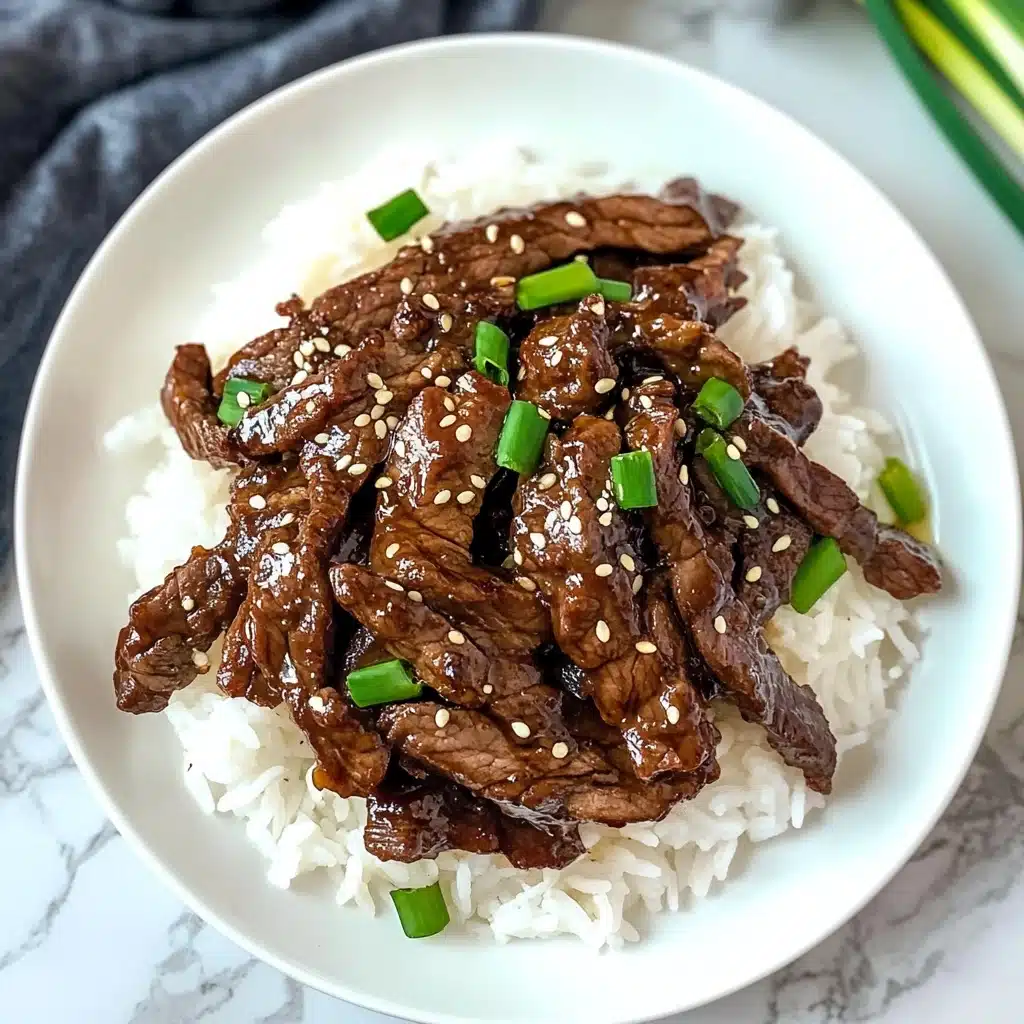
Garnishes
A sprinkle of sliced green onions and toasted sesame seeds are non-negotiable for me—they add crunch, color, and that telltale nutty fragrance that wafts up with every bite. For extra freshness, try a scatter of chopped cilantro or a few slivers of raw chili if you want more heat.
Side Dishes
Korean Beef Bulgogi is incredible piled over steamed white rice, but it also plays beautifully alongside banchan (Korean small side dishes) such as kimchi, pickled radish, sautéed spinach, or even a crisp cucumber salad. If you want something heartier, serve it with sticky rice cakes or a big bowl of Japchae noodles for a feast.
Creative Ways to Present
I love serving bulgogi family-style, letting everyone build their own rice bowls or fresh lettuce wraps right at the table. You can also roll the beef with rice in seaweed sheets for quick bulgogi “sushi” bites, or even load it into toasted buns for the best-ever Korean beef sliders at your next get-together.
Make Ahead and Storage
Storing Leftovers
Cool your leftover bulgogi completely, then refrigerate it in an airtight container for up to 4 days. The flavors only get richer overnight, so it makes for a next-day lunch that’s arguably even better cold or reheated!
Freezing
You can freeze uncooked, marinated beef for up to two months—just defrost overnight in the fridge and cook as usual. Leftover cooked bulgogi also freezes well (up to 2 months), but be sure to wrap it tightly to preserve its juicy bite and flavor.
Reheating
For the best texture, quickly reheat your Korean Beef Bulgogi in a hot skillet, stirring just until warmed through. Avoid microwaving if possible, as it can toughen the beef—just a few minutes on the stovetop is all you need to bring back that fresh-cooked taste.
FAQs
-
Can I use a different cut of beef for bulgogi?
Absolutely! While flank steak is traditional, I’ve had excellent results with ribeye, sirloin, or even tenderloin. The key is to slice it super thin across the grain for that signature bulgogi tenderness, regardless of the cut you choose.
-
Do I have to use Asian pear in the marinade?
Asian pear is classic for both tenderizing the beef and adding subtle sweetness, but if you can’t find it, try a ripe Bosc pear or even a Fuji apple. Both work beautifully to soften the meat and give a lovely taste.
-
Can Korean Beef Bulgogi be made ahead?
Definitely! The beef can marinate overnight (which actually enhances the flavor) and cooked bulgogi reheats well in a skillet. It’s ideal for meal prep or entertaining so you’re not cooking at the last minute.
-
How spicy is Korean Beef Bulgogi? Can I adjust the heat?
The recipe has just a touch of heat from red pepper flakes, but you can easily adjust it up or down. Want it spicier? Add more flakes or a spoonful of gochujang. Prefer it mild? Simply leave the spice out.
Final Thoughts
If you’re looking for a rewarding meal that’s absolutely bursting with flavor, you owe it to yourself to make Korean Beef Bulgogi at home. Treat yourself to those sweet, smoky, savory bites—it’s easier than you think and sure to win over everyone at your table!
Print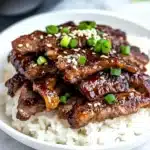
Korean Beef Bulgogi Recipe
- Prep Time: 15 minutes
- Cook Time: 15 minutes
- Total Time: 3 hours
- Yield: 4 servings
- Category: Main Course
- Method: Grilling, Marinating
- Cuisine: Korean
- Diet: Gluten Free
Description
This Korean Beef Bulgogi recipe is a delicious and savory dish that features tender slices of marinated beef cooked to perfection. The marinade infuses the meat with a perfect blend of flavors, making each bite a culinary delight.
Ingredients
Marinade:
- 1/4 cup reduced-sodium soy sauce
- 1 tablespoon rice vinegar
- 3 tablespoons light brown sugar
- 2 tablespoons sesame oil
- 5 cloves garlic, minced
- 1 tablespoon freshly grated ginger
- 1/2 cup Asian pear, grated
- 1/8 teaspoon red pepper flakes
Other Ingredients:
- 2 pounds flank steak, sirloin, tenderloin, or Ribeye
- 2 tablespoons vegetable oil, divided
- 2 green onions, thinly sliced
- 1 teaspoon toasted sesame seeds
Instructions
- Chill the Steak: Wrap the flank steak in plastic wrap and freeze for 3 hours. Slice into thin pieces.
- Marinate: Combine all marinade ingredients. Marinate steak slices for 2-3 hours or overnight.
- Cook: Heat a grill pan, cook steak slices in batches until charred, about 2-3 minutes per side. Serve over rice garnished with green onions and sesame seeds.
Notes
- For extra flavor, consider grilling the marinated beef on a barbecue.
- Adjust the level of red pepper flakes to suit your spice preference.
Nutrition
- Serving Size: 1 serving
- Calories: 380
- Sugar: 12g
- Sodium: 670mg
- Fat: 21g
- Saturated Fat: 7g
- Unsaturated Fat: 12g
- Trans Fat: 0g
- Carbohydrates: 16g
- Fiber: 1g
- Protein: 35g
- Cholesterol: 95mg

